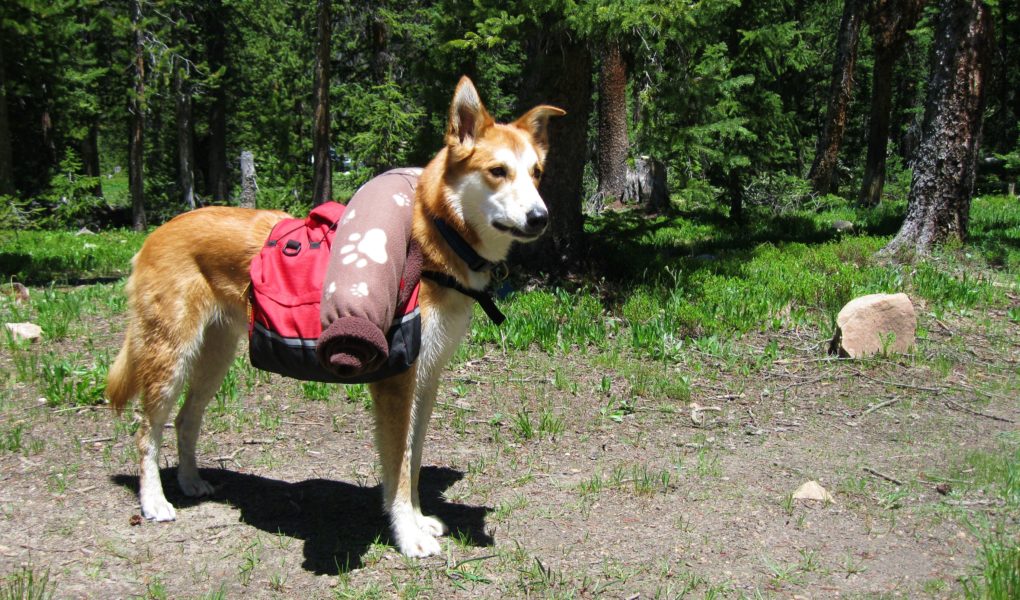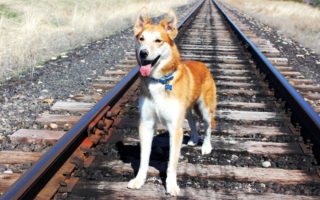Why Would You Backpack With Your Dog?
There’s a few reasons why someone may want to invest in a backpack for their dog. The typical reason may be for the outdoorsy sort who likes to go on week long hiking trips with their canine companion and needs them to carry their own supplies. Another may be for training purposes. Some dogs with behavioral issues can benefit from carrying a load in a backpack while going on a walk. This gives the dog a sense of work and having a job to do which benefits them mentally. Finally, someone may just have a very high energy dog, and not a enough time on their hands to do a proper length walk. A backpack can tire a dog out faster, turning a 30 minutes walk, into the equivalent of an hour.
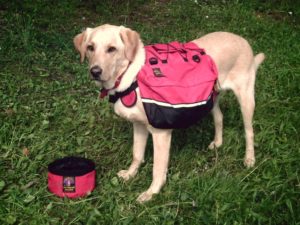
The Backpack Itself
The first step is finding a good backpack for your dog. You should be safe getting any backpack specifically designed for dogs though some are going to be a better fit than others. You’ll want to consider whether or not your going to be using the backpack long term, how often your going to be using it, and the shape of your dog. Some key points to pay attention to are . . .
–Pack Size: Figure out how large of saddle bags your pack is going to need to be for the type of activity your going to be doing.
–Proper Padding: Ensure there’s proper padding for sensitive areas on your dogs body so they don’t chafe.
–Durable Material: Look for materials that won’t fray or tear at the seams.
–Type of Material: Decide whether or not you need something waterproof, or something more cloth like.
–Design: Decide what kind of extras you want the pack to have such as a handle on the top, clips vs velcro, additional d-rings to clip things on, etc.
–Pack Placement: Your dogs back is not meant to support a lot of weight, so it’s important to find a pack in which the weight will sit more on the shoulders. If you end up buying a longer pack that extends to the back, make sure to pack the heavier items more towards the shoulders.
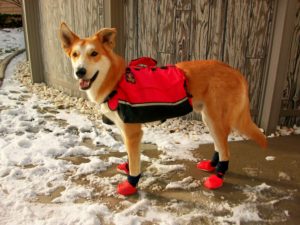
Training & Preparation
A young healthy dog can carry roughly 25% of their body weight, but they need to be trained up to that point. You’ll want to see what your dog thinks of the pack empty before going a head and adding a little weight on each side. Make sure the pack fits snugly, but not too tight. Also, make sure the weight is equal on both sides of the pack to help keep it upright and prevent it from sliding to one side. Depending on how active you are with your dog, try starting off with 30-60 minutes excursions. If they do well, you can try adding more weight the next time. If they appear sore afterwards, check for chafing and ease up on the weight. Once you’ve reached 25% of their body weight, you can work on endurance by extending the length of the walks by 15-30 minutes each time with the pack on.
How far your dog can go will depend on their physical build, nutrition, and training. A wolf in the wild can travel roughly 20-30 miles per day. However, most domesticated dogs are not exposed to that much activity and even the most active and conditioned family dog would be more comfortable with 5-10 miles per day. It all depends on the breed, how much training they get, and how physically sound they are. Never push your dog too far, and stay attentive to what their limits are.
Nutrition also plays a large roll in your dogs endurance. Make sure you’re feeding a high quality food. Most avid hikers I’m sure, take care of their own health, and invest in eating healthy foods. The same should be done for your dog. Holistic or not, traditional kibble is the equivalent of what cereal is to us. Highly processed, and sprayed with vitamins and minerals. The better your dogs diet, the better they’ll do on the trail, and the longer they’ll be able to do it for. I’ll always recommend a raw food diet for dogs. Link to my raw dog food diet post included at the bottom.

What To Pack?
What you pack will depend on what your using the backpack for. If you’re simply using it on your daily walk with your dog, you may just be packing weights or water bottles, and of coarse poop bags. If it’s summer, it may be a good idea to pack ice packs to help keep your dog cool. If your planning a backpacking trip, then there’s a few other items you may find necessary . . .
Food: Keep in mind that you will want to pack larger meals for your dog to compensate for the increased burn in calories. It’s also a good idea to pack a little bit extra just in case your trip ends up being longer than expected. Dehydrated/Freeze Dried food will be lighter, and therefore you should be able to pack more of it. They will also require more water, and just like any dog food, you’ll want to ensure that’s your dogs stomach is okay with it and switch them over to it gradually.
Water: If you’re packing for more than a day or two, then your dog may not be able to carry their own water due to the weight. Some people however, like to carry a water filters/treatments meant for the back country so that their dogs can have purified drinking water. Personally, as long as the water source is clean like a lake or stream, I just let my dogs drink straight from the source.
First Aid: A simple first aid kit may come in handy if your dog ends up with any cuts or stings on your hiking adventure.
Booties/Shoes: Some dogs feet are more delicate than other, but if you’re dogs been properly conditioned then their feet should be fine as is. However, if you plan a trip on unusual terrain that your dogs feet may not be used to like rocks or sand, then you may want to invest in shoes made for dogs for those specific trips.
Poncho: A poncho could come in handy if you get caught in the rain and want to keep fido nice and dry. I found it cheaper to make my own by modifying a poncho meant for a person.
Treats: I don’t often pack treats as they take up precious space in the pack, but if you have room, they can offer a small power boost to your pup while your on the trail. They could also be used for training.
Poop Bags: It’s always good to have some of these on hand. Depending on whether or not your hiking somewhere public vs more in the back country, you’ll want to remember to bring poop bags.
Collapsible Bowls: In the interest of saving space, you should only need one collapsible food to use for food and water.
Pad: If you have room and your dog can handle it, pack a lightweight pad that your dog can rest on when your settling into camp.
Ultimate, what you bring depends on the length of your trip, how much space is in the pack, and how much weight your dog is trained to handle.
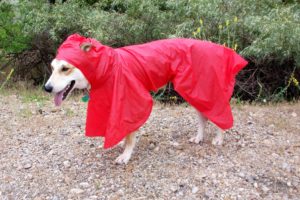
Controlling Your Dog
If you do a lot of off leashing with your dog(s) and they naturally stick close to you, congrats. Otherwise, you may want to consider having them on leash when they have a backpack on. The last thing you want is your dog running wild and catching their backpack on bushes, trees, etc. Especially is your dog reacts to seeing wildlife. If you’d prefer to be hands free but your dogs on the wondering side, you can try training your dog to stick close with an e-collar. Eventually you can teach your dog there’s a time for packing and traveling, and then give them their time to wonder and sniff once you’ve reached your resting point.
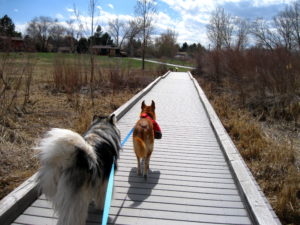
Related Posts:

